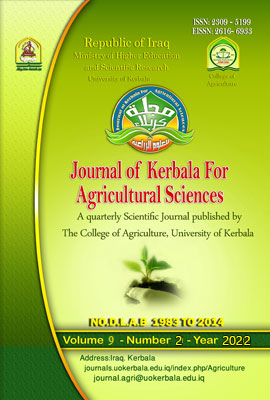Effect of using raw and treated quinoa seeds (Chenopodium quinoa) in the diets on some microbial, physical and chemical properties of broiler carcass
DOI:
https://doi.org/10.59658/jkas.v9i2.961Abstract
The experiment aimed to study the use of different proportions of raw and treated Chenopodium quinoa seeds by soaking in the diet in order to identify the effect in the physical and chemical traits of meat and the numbers of bacteria in the duodenum of 42 days of age. A 336 sexed broilers (Ross 308) were distributed randomly at one day old, with an average initial weight of 39 g/chick, divided into seven treatments, 48 chicks/treatment, each treatment included three replicates, 16 chicks/replicate (8 males and 8 females). The chicks were fed on the starter diet (1-14) days of age, the grower diet of (15-28) days of age, and finisher diet (29-42) days of age, supplemented with raw quinoa seeds and treated by soaking as the first treatment (T1) was a control treatment without any addition. (T2) added 0.5% raw quinoa seeds, (T3) added 1% raw quinoa seeds, (T4) added 1.5% raw quinoa seeds, (T5) added 0.5% quinoa seeds treated with soaking, (T6) added 1% quinoa seeds treated with soaking, (T7) added 1. 5% quinoa seeds treated with soaking. The results showed a significant (P<0.05) increase in the average numbers of Lactobacillus bacteria in favor of treatments T4, T6, T7. In contrast, there was a significant decrease in the numbers of coliform bacteria in favor of the addition treatments T3, T4, T5, T6, and T7 compared to control treatment. As for the results of the physical traits, it achieved a significant decrease in the percentage of each of the drip loss and the weight lost when dissolve for all addition treatments, and in favor of the T4 treatment the percentage of loss during cooking and a significant increase in the water holding capacity in favor of all the addition treatments compared to the control treatment. As for the chemical properties, it was found that there was a significant increase in the pH values and myoglobin pigment for meat in all the addition treatments compared to the control treatment (T1).
Downloads
Published
How to Cite
Issue
Section
License
Copyright (c) 2022 Copyright (c) 2024 is the Author's article. Published by the Journal of Kerbala for Agricultural Sciences under a CC BY 4.0 license

This work is licensed under a Creative Commons Attribution 4.0 International License.
Licensing Terms
All articles are published under a Creative Commons License and will be directed to the Creative Commons Attribution 4.0 International License (CC BY 4.0) That permits use, distribution, and reproduction in any medium, provided the original work is properly cited. This license also allows the work to be used for commercial purposes.
Use by both non-commercial and commercial users
This content is licensed under a Creative Commons Attribution 4.0 International (CC BY 4.0) license, permitting use by both non-commercial and commercial users. Individual users may access, download, copy, display, and redistribute the articles to colleagues, as well as adapt, translate, and text- and data-mine the content, subject to the following conditions:
- The author's moral rights, including the right of attribution and the right to protect their work from derogatory treatment, are respected.
- Where content in the article is identified as belonging to a third party, users must ensure that any reuse complies with the copyright policies of the owner of that content.
- If the article content is reused for research or educational purposes, users should maintain a link to the appropriate bibliographic citation, including the DOI and a link to the published version on the journal's website.

